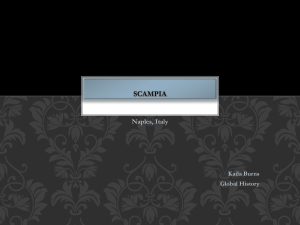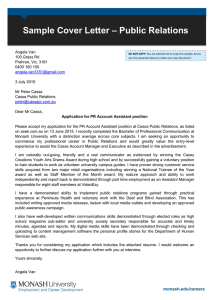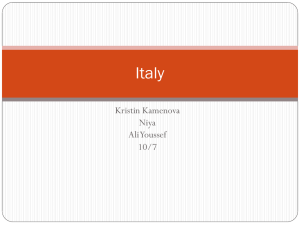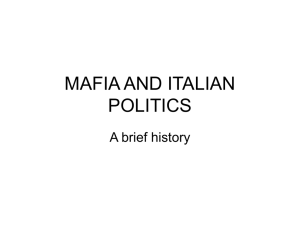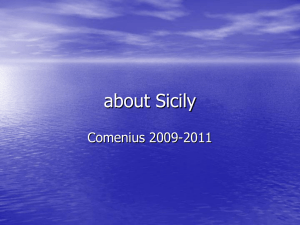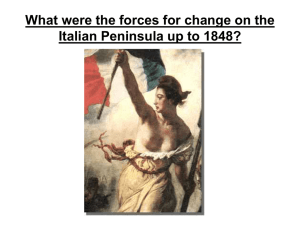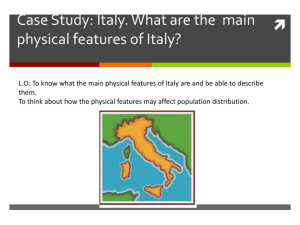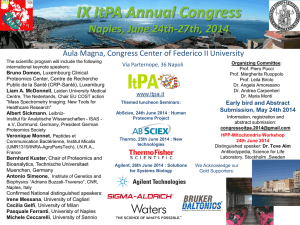MEZZOGIORNO REGION
advertisement
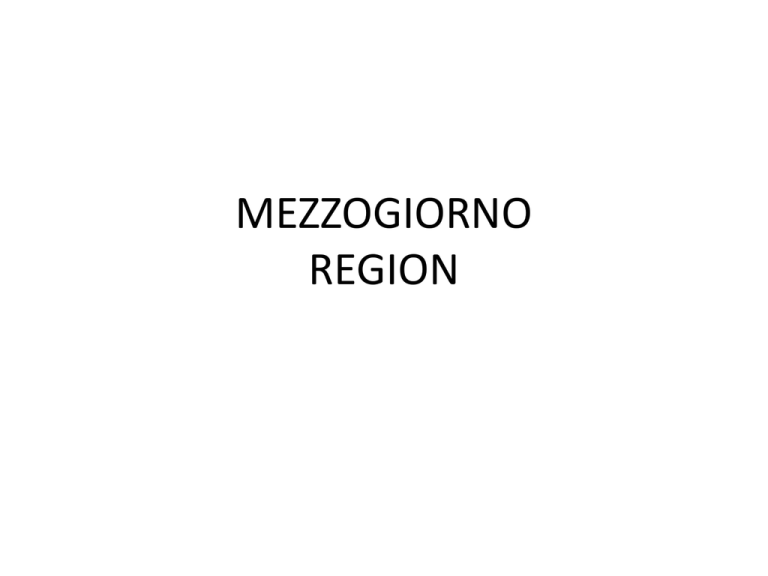
MEZZOGIORNO REGION Mezzogiorno: A peripheral region The Italian peninsula south of Rome + Sardinia & Sicily – 40% of land area and 35% of pop but only 26% of GDP High dependence on agriculture, high unemployment, low wages (70% of north) and high emigration (9million in last 100yrs) Physical: 85% is either mountainous or hilly, Apennines are dominant mountain range, 40km to 200km wide… rugged & steep. Thin soils & a narrow coastal plain. 2 areas of coastal lowlands Naples-Salerno and the Puglia lowlands, most productive agricultural areas Despite this they are poorly drained mudflats and marshes e.g. Pontine Marshes south of Rome, mosquitos make them a health hazard Active volcanoes e.g. Vesuvius & Etna affect the area which is also subject to earthquakes eg. Puzzuoli in Bay of Naples located 3.5km above a magma chamber…. 1983 chamber opened & poured into harbour. Deforestation & over grazing led to soil erosion. Few Rivers as the area is limestone and the river quickly disappear underground The Volturno flows into the Tyrrhenian sea and the Pescara flows into the Adriatic Soils: Most fertile soils found along the flanks of volcanoes and also along the existing river valleys and their floodplains i.e. Volturno and Ofanto Majority of soils thin and infertile and require irrigation and fertilisers Terra Rossa soils cover much of the Mezziogiorno, formed by weathered limestone and have a deep red colour(favoured by wine growers) but most affected by drought and overgrazing Climate & Vegetation Mediterranean, hot dry summers…. 9 to 29°C Azores High pressure belt brings clear skies and warm sunshine while the north east trade winds bring drought from June to September between 10 and 100mm rainfall pa. with regional variations. Summer the hot Sirocco winds scorch the area. Winters are mild and moist with rainfall varying from 500mm- 900mm pa in the west to 400mm pa in the east. Summer the hot Sirocco winds scorch the area(blow from the Sahara) Convectional Rain in summer causes downpours and often leads to mudslides increasing soil erosion. Climate strongly effects agric. Plain of Campania around Naples most productive region…. Fertile ash soils from Vesuvius. Grow wheat, maize & salad crops + pear, plum & peaches. Pressure on land & villages built on slopes. Fishing on a small scale + limited forestry & some oil & gas make up the rest of the primary sector. Agriculture: Limited by climate, soil & terrain. Small farms, lack of mechanisation. Rely on wheat & tree crops… limes, lemons, oranges, olives, figs & grapes. Roots bind well to soil & olive trees roots extend to water table & release less moisture. Winter wheat… mild moist winter & harvest early summer. Sheep & goats on the hills Primary Economic Activities • Agriculture: – – – – – – Sheep Grazing upland, soil erosion 10% of workforce Incomes 50% lower than EU average High dependency on EU grants Tree crops such as vines, olives etc Until 1950 land was divided into estates called Latifundi and plots rented by peasants called minifundia – These labourers were called braccianti – Average farm size was 3 ha so they were overcultivated and overgrazed – Production levels low as farmers didnt own land so no incentive to improve them • Forestry: – Upland areas, limited rainfall – Scrub vegetation • Fishing: – Small continental shelf, limited – Pollution of Mediterranean – Local tourist trade • Mining: – HEP production limited – Natural gas piped from Algeria Challenges facing agricultural development • Before 1950: – Underdeveloped water supplies and drought – Poorly educated – Outmigration – Poor use of technology with aging farmers – Limited buying power in local market – Unfair ownership of land, only 1 quarter owned their farms – Poor transport network • Positive Effects of Cassa: Land Reform – Estates bought by govt and redistributed in 5 hectare farms New Farming Techniques, Cash crops Mechanisation investment Irrigation schemes – Apulian Aqueduct Co-operatives were formed to help sell produce in North Improvements in Infrastructure – Autostrada del Sole Malarial swamps drained – reclaimed marshes of Metapontino • Output increased tenfold • Main producer of citrus fruits and olives in Europe • Negative Effects: • Reforms mainly benefitted the coastal plains • Widened gap between upland and lowland • 200% increase in tomatoes led to seasonal overproduction and dramatic fall in prices Secondary Activities • 24% of people employed in Secondary • 17% were in Mezzogiorno prior to Cassa • Mezzo was bypassed because: – Workforce poor and uneducated – Poor local markets and upland terrain – Peripheral location – Lack of natural resources – Limited food processing industries – Long distance from eu markets – Little local capital – Brain drain Cassa • • • • • • • • • 1957onwards focused on Secondary Varoni plan invested 2.3billion between 1965-1970 300,000 jobs created Grants, subsidies and tax relief 40% of new state companies had to be in south Industrial estates and transport subsidies International Airport at Calabria Autostrada del Sole – 1000km Heavy Industries accounted for 60% of investment in south • Growth pole of Bari-Brindisi-Taranto triangle Cassa several growth poles They focused on steel, shipbuilding, auto manufacture, oil refining and chemicals (Bari, Brindisi & Taranto industrial triangle and Naples for chemicals, oil refining and car manufacture) in response to the poor level of manufacturing. By 1962 60% of Cassa’s budget was in manufacturing. Created 300,000 jobs in industry Tax concessions, grants, loans given to companies to set up. Alfa Romeo… assembly plant at Naples Fiat… components & assembly plants employing 44,500. Petro-chemical industry… oil refineries & petro-chemical plants e.g. at Brindisi & Taranto. Steel plants… Taranto & Palermo Set up port industries like oil refining, chemicals, shipbuilding (Bari), engineering. Deep water ports were developed at Catania and Ragusa on the east coast of Sicily State owned companies spent over 40% of their investment in the region. Taranto: Pop – 210,000 Located in Puglia Long maritime tradition, location on the Med, natural deep water harbour, improved rail and motorway linkage to northern italy Also an important naval base and the area is strongly fortified Port 3rd biggest in Italy and handles 36million tonnes of freight annually Imp steel works located there but employment dropping due to increase competition from low cost producers Further expansion is limited by: distance from markets and shortage of skilled labour Finsider Steelworks, Taranto • Most successful state owned investment • Italys biggest Steel works • Taranto port handled 36million tonnes of freight in 2002 • • • • 1970’s cassa focused on labour intensive industries Cassa disbanded in 1984 EU structural funds gave 13billion between 1989-1993 Current worfforce is 1.4m and outmigration has lessened Problems: Capital intensive industries (oil refining) providing small number of jobs. Town planning & industrial development needed to be integrated. Lack of training & skill shortage. Continued out-migration from rural areas. Industries not suited to their specific location. 1970’s these issues addressed. EEC funds, state owned companies spend 80% of their investment in the Mezz. Emphasis on environmental protection, integrate tourism industry & labour intensive food processing, sourced locally. Programme ended in 1984. Corruption (mafia) led to embezzled funds. Privatisation of state companies reduced investment in the region. By 2000 unemployment still at 20% in some areas. Negative Cassa • • • • • • • • • • • • Heavy Industry created very little spin off industry Oil refineries – capital intensive and very little jobs Environment not a priority – polluted water 2m jobs in agri lost due to mechanisation Over reliance on state investment Unemployment still high at 20% Not an equal spread – naples a beneficiary Infant mortality 4 times higher than northern Italy Housing is substandard 24 % of children leave education after primary school Foregin companies nervous of mafia influence Infastructure still lags behind the north Limited Success • Most factories were capital intensive – provided little employment • Many workers were part time farmers which lowered production • Large Industries failed to attract other industries • Industrial jobs created failed to match those lost in agriculture • Workers not properly trained • Town planning and industrial development not coordinated so often built far apart • Over reliance on state investment • Privatisation of industry has allowed a lot of them to move back north • Cassa finished up in 1984 Tourism 67% or 17million Tourists •Rich Culture… Greek, Roman & Arabic historical mix •Climate – sun guaranteed •Scenery + Etna & Vesuvius •Historical sites… Pompeii •Coast… Amalfi coast, Apulian Coast •Good infrastructure… ferry, airports & motorway. •Adriatic coast has a lot of Greek and Roman influence •Cheaper and less crowded than other alternatives •(Cassa spent 15% of budget on tourism developing 25 locations by upgrading acc and providing grants for facilities) • • • • Growth of Tourism began in 1950’s Package holiday, cheap flights and paid holdiays from work Limited to coastal regions due to accessibility 15% of cassa budget spent on Tourism – Improved hotels and self catering facilities – Communications – Airport at Calabria, Ferry links to Siciliy and Sardinia – Developed 25 tourist areas – These increased demand for local farm produce – 2/3 of tourists from northern Italy – Failed to attract lucrative foreign market – Employment seasonal as no skiing option in winter – Environmental pollution and inflated land prices – Strained water supply – International tourism coming- Ryanair fly London-Bari – Starting to develop skiing in Apennines • Transport: – 2.5 Million euro of Cassa Autostrada – Ports Taranto,Sicily, Gioia Tauro, 1995 employed 1000 people GDP per capita Unemployment Hospital beds per 1000 North of Italy 25,527 4.2% 4.4 Mezzogiorno 13,028 15.0% 3.9 Human Processes: Life Expectancy Improving – men 76 + women 82 13.2 births per 1000 (high) but decreasing due to education Population density varies Low fluctuation stage Hilltop villages, humidity, Malaria, protection Naples 1.2million, 3rd largest city People descended from Greeks, Romans & Arabs. Influence of different cultures. Area a crossroad for Mediterranean trade & many invaders. Result: Sallow skin, dark haired & smaller than northern Italians. Arabs introduced oranges, lemons & sugar cane to the area. Language: Italian, Catalan, Spanish, Sard & Arabic. Local dialects of Sicilian & Neapolitan…. reflecting past history. Population: 21million (36% of Italy). Overall reduction in family size due to education, rise in living standards, & decline of Catholic church influence. Death rate below the birth rate so overall a slight natural increase in pop. Migration: Outward. Major factor in pop. change in the area. Move to North of Italy & USA 1951 to 1971 total 4 million. Inward: Balkan refugees & African. Pop. density & distribution varies greatly due to relief, land system & migration. Sicily: Invaded by Greeks, Romans, Arabs & Normans. Unified under Italy in 1860’s. Led to a mistrust of outside rule. Resulted in Mafia & corruption. Major Problems that threaten improvement • • • • • • • • Organised Crime Political corruption Outward migration High unemployment Slow economic development Low literacy levels High dependency ratio Poor healthcare system Port of Gioia Tauro • New container port in Calabria opened in 1995 • Second largest container port in the Med • Gioia Tauro is now a transport hub for transhipment to 12 countries around the Med • Since 1998 its the southern terminal of rail routeway that allows quick shipping to North sea coast – journey of 2500km to rotterdam takes 42hrs • Employs 1000 and local town of 18,000 is experiencing growth Naples • • • • • Founded by the Greeks in 600BC Largest city in Mezzogiorno and 3rd in Italy City pop is 1.2 but total urban pop is 3m Located in beautiful bay near Vesuvius Naples reputation is one of crime, gridlock and the Mafia • City and infrastructure benefitted from Cassa but unemployment still 20% • Informal economy is strong i.e. They dont pay taxes e.g. Clothing, footwear etc • Tourism is very big, Pompeii, Herculaneum and the Isle of Capri • Urban renewal has given the city a facelift and modernised it • Neapolitans have deep mistrust of government and political leaders and look to themselves to develop economically Sicily • Centre of Med where shipping lanes pass so colonised for centuries • Greek, Roman Aran and Norman influences • Reunited with Italy in the late 19th C • Distrust of outside ruler which led to mafia in 18th C • Mafia offered protection to Islanders from foreign rulers for a price • Sicilian Provinialism led to continuation of Mafia after unification • Omerta – Code of silence – very hard to break the Mafia • Local politicians have strong links with the Mafia • Public prosecutors targeted by mafia • Many convictions overturned on technicalities by a judge later convicted of membership
